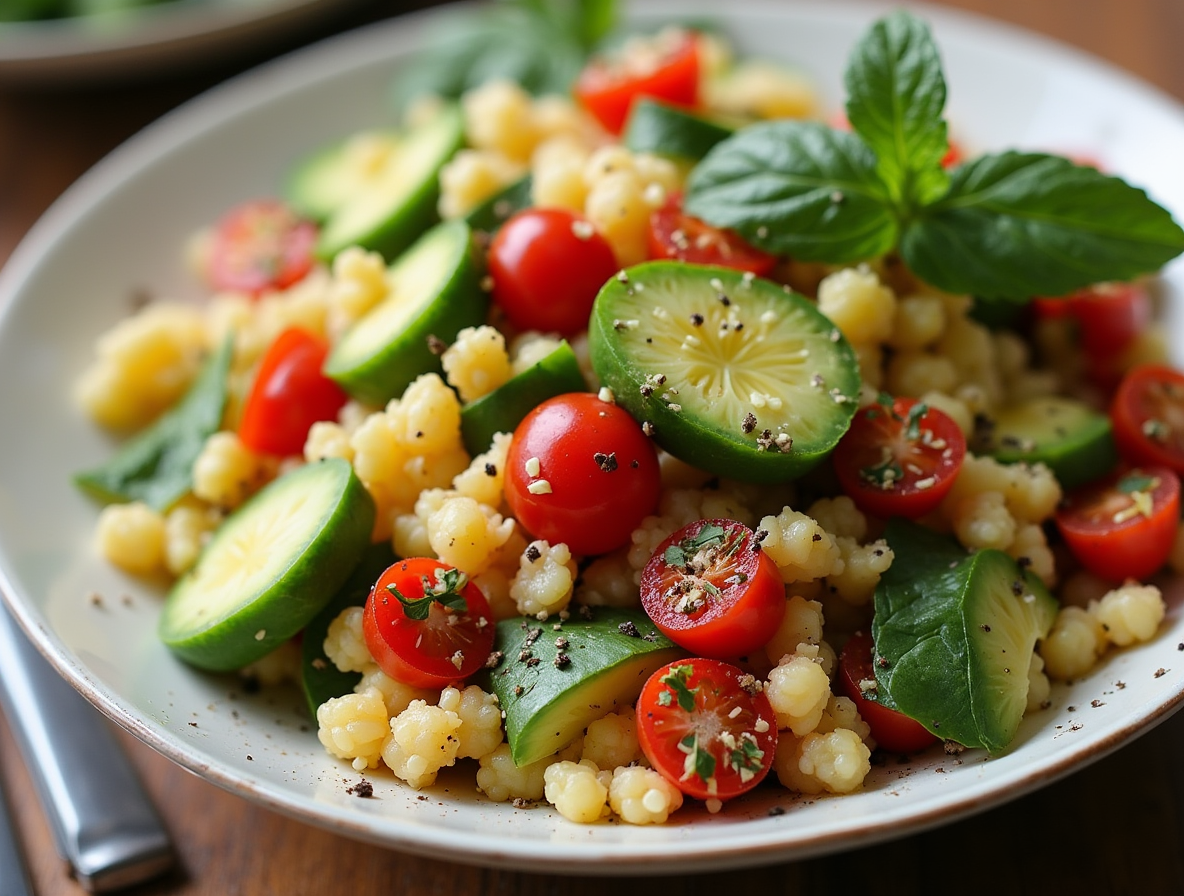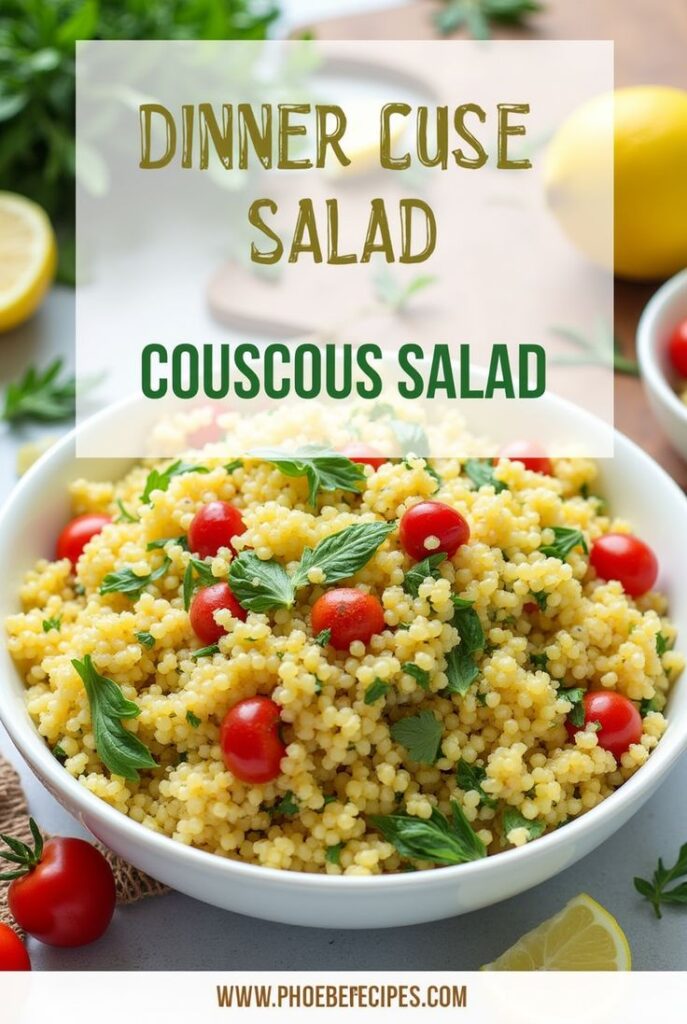How to Make Perfect Couscous Salad: A Chef’s Simple Guide
Did you know a delicious couscous salad can be prepared in just 20 minutes? This staple from Morocco and Northern Africa has become one of my favorite go-to meals when I need something quick yet nutritious.
Pearl couscous (also known as Israeli couscous) offers a delightful nutty flavor and chewy texture, especially when toasted before cooking. What I love about Mediterranean couscous salad is its perfect balance of nutrients – fiber-rich vegetables, protein from chickpeas, and a vibrant dressing that brings everything together. Additionally, simple couscous recipes are incredibly versatile, allowing for countless variations based on what ingredients you have on hand. In fact, a basic couscous recipe can be transformed into an impressive meal with just a few fresh components.
Throughout this guide, I’ll share my chef-tested methods for selecting the right type of couscous, cooking it perfectly, building a flavorful base, and creating a dressing that elevates the entire dish. Whether you’re looking for a light lunch option or a side dish for dinner, this couscous salad recipe will certainly become a staple in your culinary repertoire.
Choosing and Cooking the Right Couscous
Couscous is not actually a grain but a tiny pasta made from semolina flour derived from durum wheat. Understanding the different varieties is essential for creating the perfect couscous salad base.
Types of couscous: pearl, Moroccan, Israeli
The primary difference between couscous varieties lies in their size. Moroccan couscous is the smallest type, featuring tiny granules even smaller than quinoa. This traditional variety cooks incredibly fast, making it perfect for quick meals.
Pearl couscous (sometimes called Israeli couscous) consists of larger, round balls about the size of peppercorns. Although often used interchangeably with Israeli couscous, pearl couscous has a more chewy texture and absorbs flavors beautifully.
Interestingly, Israeli couscous was developed in Israel during the 1950s as a rice substitute during food rationing. While similar to pearl couscous, it’s specifically made by extruding dough through a die rather than rolling it into granules. Some experts consider it not true couscous in the traditional North African sense.
For hearty salads, there’s even Lebanese couscous (moghrabieh), which features the largest granules—about pea-sized. This variety works wonderfully in substantial salads that need more texture.
How to cook couscous for salad
Each type requires a different cooking method. For Moroccan couscous:
- Bring 1 cup of water or broth to a boil with a pinch of salt and a teaspoon of olive oil
- Add 1 cup of couscous, stir quickly, then remove from heat
- Cover and let stand for 5 minutes until tender
- Fluff with a fork and let cool before adding to salad ingredients
Pearl or Israeli couscous needs to simmer longer:
Bring salted water to a boil, add the couscous, and cook for 8-10 minutes until al dente. Drain immediately and toss with a little olive oil to prevent sticking.
For couscous salad, I always let the cooked couscous cool completely before mixing with raw ingredients. This prevents the vegetables from wilting and losing their structure.
Toasting couscous for extra flavor
Beyond the basic cooking methods, toasting dry couscous beforehand creates remarkable depth and a nutty flavor profile. To toast couscous:
Add a tablespoon of olive oil to your pot over medium heat, then add the dry couscous. Stir constantly until the granules turn golden brown. Subsequently, proceed with your regular cooking method using boiling liquid.
For pearl couscous, toasting is particularly effective. The larger granules develop a beautiful golden color and enhanced nuttiness that pairs wonderfully with Mediterranean ingredients. Furthermore, this simple step transforms an ordinary couscous salad recipe into something distinctly more sophisticated.
Building the Perfect Couscous Salad Base
Creating a vibrant couscous salad begins with selecting the right ingredients to complement your perfectly cooked grains. First and foremost, the best couscous salad recipes balance textures, colors, and flavors for a truly satisfying dish.
Fresh vegetables to include
The foundation of any excellent couscous salad recipe includes a colorful array of fresh vegetables. English cucumbers work wonderfully as they have thinner skin and smaller seeds than regular cucumbers. Cherry or grape tomatoes add bursts of sweetness without making the salad soggy. For crunch and color, consider these additions:
- Bell peppers (especially red for sweetness)
- Zucchini (raw or grilled for extra flavor)
- Red onion (finely diced for mild pungency)
- Carrots (cut into small sticks for crunch)
- Radishes (for a peppery bite)
For a Mediterranean couscous salad, you might also include marinated artichoke hearts or kalamata olives. Moreover, many chefs recommend chopping vegetables into small, uniform pieces so you get a little bit of everything in each bite.
Protein options like chickpeas or beans
Chickpeas reign supreme as the protein of choice in couscous salads. Beyond adding protein, they contribute fiber and essential vitamins. Simply drain and rinse canned chickpeas before adding them to your salad. Other excellent protein options include:
- White beans or kidney beans
- Toasted nuts (almonds, pine nuts, or walnuts)
- Crumbled feta cheese (adds protein and tangy flavor)
Herbs that enhance flavor
Fresh herbs transform simple couscous recipes into vibrant meals. Parsley is perhaps the most classic herb for couscous salads, providing a fresh, earthy note. Mint adds unexpected brightness, notably in Mediterranean-style preparations. Additionally, these herbs work beautifully:
- Basil (especially with tomatoes)
- Cilantro (pairs well with cumin-spiced dressings)
- Dill (offers a unique freshness with cucumbers)
Above all, don’t be shy with herbs—they’re essential for adding dimension and freshness to your couscous salad.
Making the Dressing and Mixing It Right
The perfect dressing can transform a basic couscous dish into something extraordinary. Indeed, many chefs consider the vinaigrette the true star of any memorable couscous salad recipe.
Simple lemon vinaigrette recipe
A classic lemon vinaigrette provides the ideal balance of brightness and richness to complement couscous. The most straightforward version requires just a few ingredients:
- Fresh lemon juice (2-3 tablespoons) – Provides the primary acidic component
- Extra virgin olive oil (¼ cup) – Creates richness and body
- Dijon mustard (1-1.5 teaspoons) – Helps emulsify the dressing
- Honey or maple syrup (1 tablespoon) – Balances acidity
- Salt and pepper to taste
Simply whisk these ingredients together in a bowl or seal them in a mason jar and shake vigorously until well combined. For extra flavor dimensions, consider adding minced garlic, lemon zest, or Mediterranean spices like cumin and coriander.
When to add dressing for best absorption
Timing is crucial when adding dressing to your couscous salad. For maximum flavor infusion, pour the vinaigrette over the couscous while it’s still warm. The heat opens up the grain’s structure, allowing it to absorb all those delicious flavors as it cools.
If you’re planning to make your Mediterranean couscous salad ahead of time, consider this approach: dress the warm couscous with a portion of the vinaigrette, then refrigerate. Just before serving, add the remaining dressing to refresh the flavors.
Nevertheless, if you’re including delicate ingredients like fresh herbs or soft vegetables, you might prefer adding them after the couscous has cooled to prevent wilting.
Balancing acidity and oil
The secret to a perfectly balanced dressing lies in the ratio of oil to acid. Professional chefs typically recommend a 3:1 ratio—three parts oil to one part acid (lemon juice or vinegar). This proportion creates harmony without overwhelming tartness.
If your dressing tastes too acidic, incorporate additional oil gradually until balanced. Conversely, if it’s too oily, add more lemon juice or a splash of vinegar. Remember that sweeteners like honey can also help temper excessive acidity in your couscous recipe.
Finally, taste your dressing before adding it to your salad. This simple step ensures your couscous salad will have the perfect flavor profile every time.
Tips for Customization and Storage
One of the greatest advantages of couscous salad is its incredible adaptability. With just a few ingredient swaps, you can create entirely different flavor profiles to suit any occasion or dietary preference.
Ingredient swaps and variations
Protein substitutions offer endless possibilities for your couscous recipes. Beyond chickpeas, try kidney beans, cannellini beans, or black beans for different textures and flavors. For non-vegetarian options, add canned tuna or grilled chicken to transform your side dish into a complete meal.
The vegetable component is equally customizable. Throughout the year, adjust your ingredients based on what’s in season:
- Summer: cherry tomatoes, corn, and cucumbers
- Fall: roasted mushrooms, Brussels sprouts, and celery
- Winter: roasted beets and sweet potatoes
- Spring: grilled asparagus, baby carrots, and radishes
For those requiring gluten-free alternatives, quinoa makes an excellent substitute for traditional couscous. Even cauliflower “couscous” works wonderfully for a low-carb option – simply pulse cauliflower florets in a food processor until they resemble couscous grains.
Make-ahead tips for meal prep
Prepping couscous salad ahead saves tremendous time throughout the week. I recommend cooking the couscous up to one day in advance and storing it separately from other components. For optimal meal prep organization, consider using containers with dividers to keep ingredients separate until serving time.
Whenever possible, store dressing separately in small leak-proof containers. This simple technique prevents soggy salads, allowing you to enjoy the perfect texture days later. Approximately three tablespoons of dressing per serving is ideal.
How to store couscous salad properly
Properly stored couscous salad maintains its freshness for 3-5 days in an airtight container in the refrigerator. On day two, refresh your salad with an extra splash of lemon juice and a pinch of salt to revive flavors.
Unlike many dishes, couscous salad often tastes even better the next day as flavors meld together. However, if you notice the couscous absorbing too much dressing over time, simply add a small drizzle of olive oil to refresh the texture.
Though freezing complete couscous salad isn’t recommended (vegetables lose their crunch), you can freeze plain cooked couscous for up to three months in freezer-safe containers. Thaw overnight in the refrigerator before building your fresh salad.
Conclusion
Couscous salad stands as one of the most versatile and rewarding dishes you can add to your cooking repertoire. Throughout this guide, we’ve explored everything from selecting the perfect couscous variety to creating balanced flavor profiles with fresh ingredients.
First and foremost, remember that the type of couscous you choose—whether Moroccan, pearl, or Israeli—dramatically affects both texture and cooking methods. Toasting your couscous before cooking adds a remarkable depth of flavor that elevates even the simplest recipes.
Additionally, the magic of couscous salad lies in its endless adaptability. You can easily customize your creation based on seasonal produce, dietary preferences, or simply what happens to be in your refrigerator. Fresh vegetables provide color and crunch, while proteins like chickpeas transform a simple side into a complete meal.
The dressing, however, truly brings everything together. A properly balanced vinaigrette with the right ratio of oil to acid makes all the difference between a good salad and an exceptional one. Above all, timing matters—adding dressing to warm couscous allows for maximum flavor absorption.
Last but certainly not least, couscous salad shines as an excellent meal prep option. When stored properly, it often tastes even better the next day as flavors continue to develop and meld together. Therefore, making a large batch at the beginning of the week provides you with nutritious, ready-to-eat meals for days.
Whether you’re preparing a quick weeknight dinner, planning lunches for the week ahead, or serving guests at your next gathering, this Mediterranean-inspired dish delivers both nutrition and satisfaction without complicated techniques. Undoubtedly, once you master the basics outlined in this guide, couscous salad will become your go-to solution for delicious, effortless meals any day of the week.
FAQs
Q1. What’s the difference between Moroccan and pearl couscous? Moroccan couscous consists of tiny granules smaller than quinoa, while pearl couscous (also known as Israeli couscous) is larger, about the size of peppercorns. Moroccan couscous cooks faster, while pearl couscous has a chewier texture and absorbs flavors well.
Q2. How do I prevent my couscous salad from becoming soggy? To avoid soggy salad, let the cooked couscous cool completely before mixing with raw ingredients. Store the dressing separately and add it just before serving. If making ahead, dress the warm couscous with a portion of the vinaigrette, refrigerate, and add the remaining dressing before serving.
Q3. What are some protein options for a vegetarian couscous salad? Popular vegetarian protein options for couscous salad include chickpeas, white beans, kidney beans, toasted nuts (like almonds or pine nuts), and crumbled feta cheese. These additions not only boost protein content but also add texture and flavor to the salad.
Q4. How long can I store couscous salad in the refrigerator? Properly stored couscous salad can be kept in an airtight container in the refrigerator for 3-5 days. To maintain freshness, you can refresh the salad on day two with a splash of lemon juice and a pinch of salt to revive the flavors.
Q5. Can I make a gluten-free version of couscous salad? Yes, you can create a gluten-free version by substituting traditional couscous with quinoa, which has a similar texture. For a low-carb option, you can even use cauliflower “couscous” made by pulsing cauliflower florets in a food processor until they resemble couscous grains.


